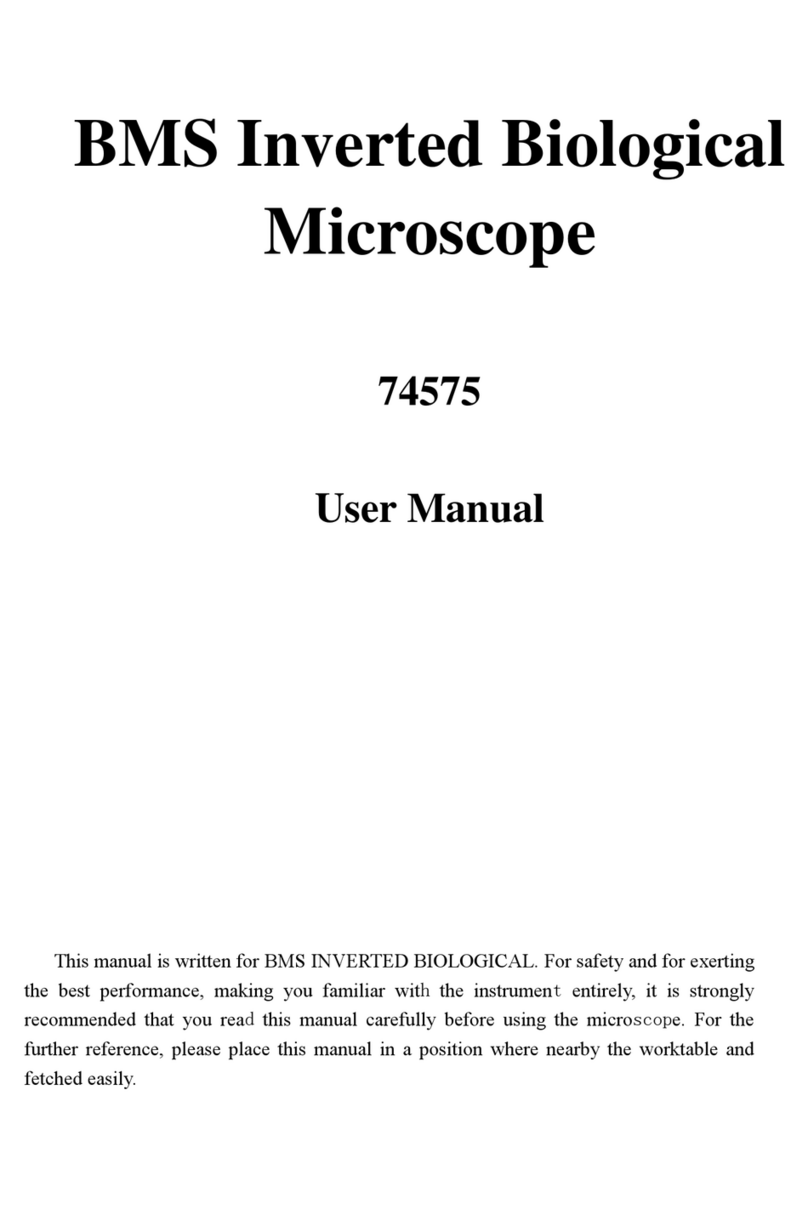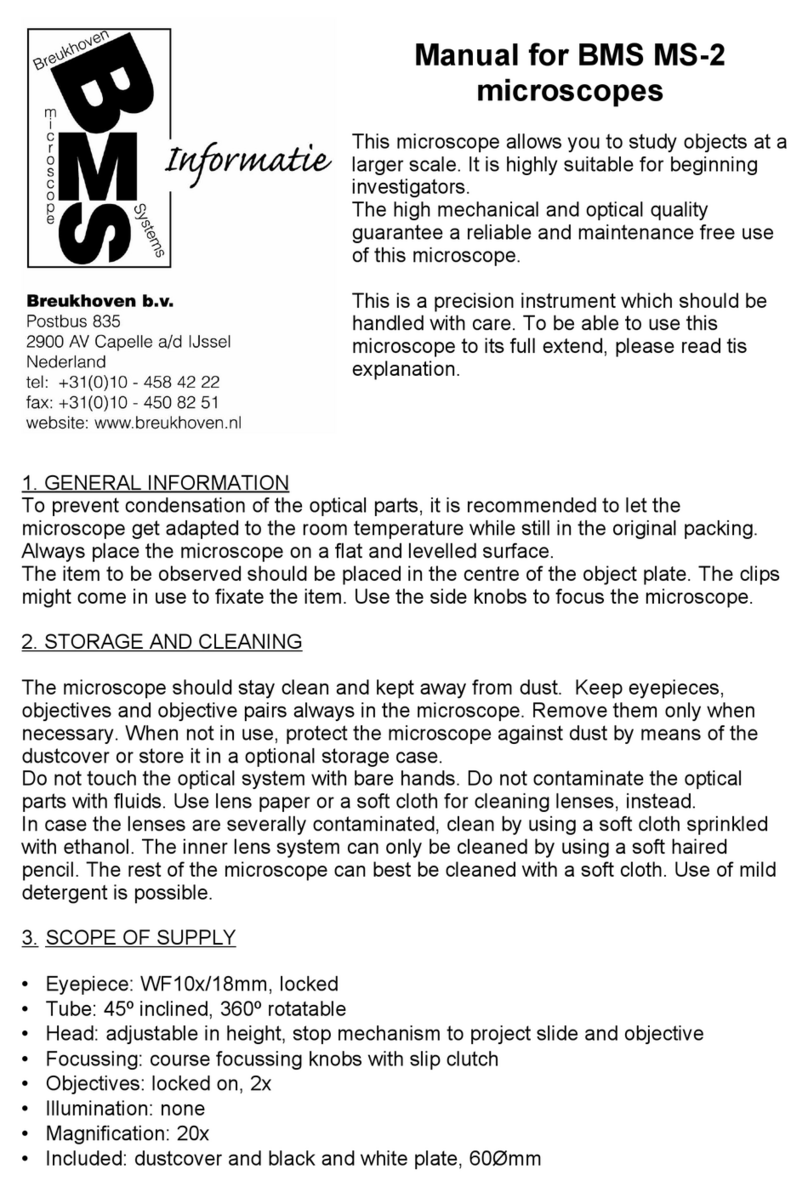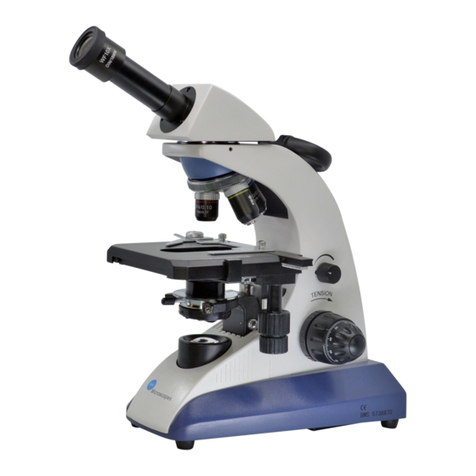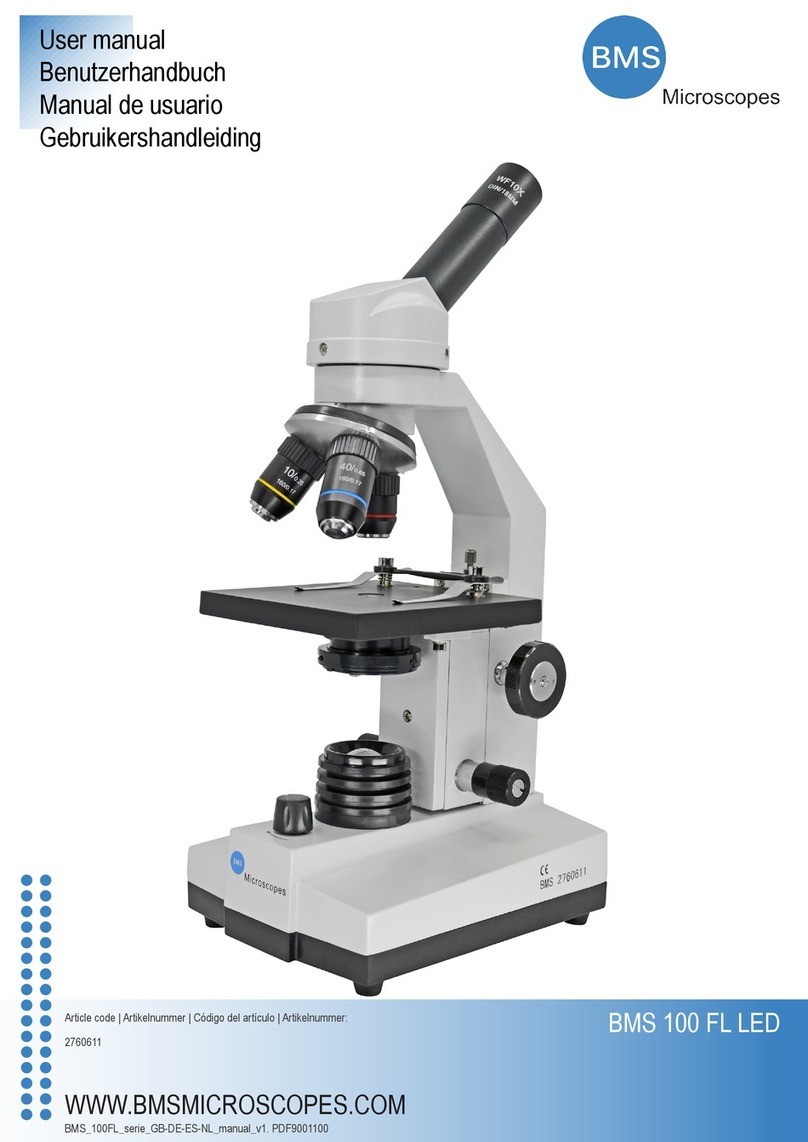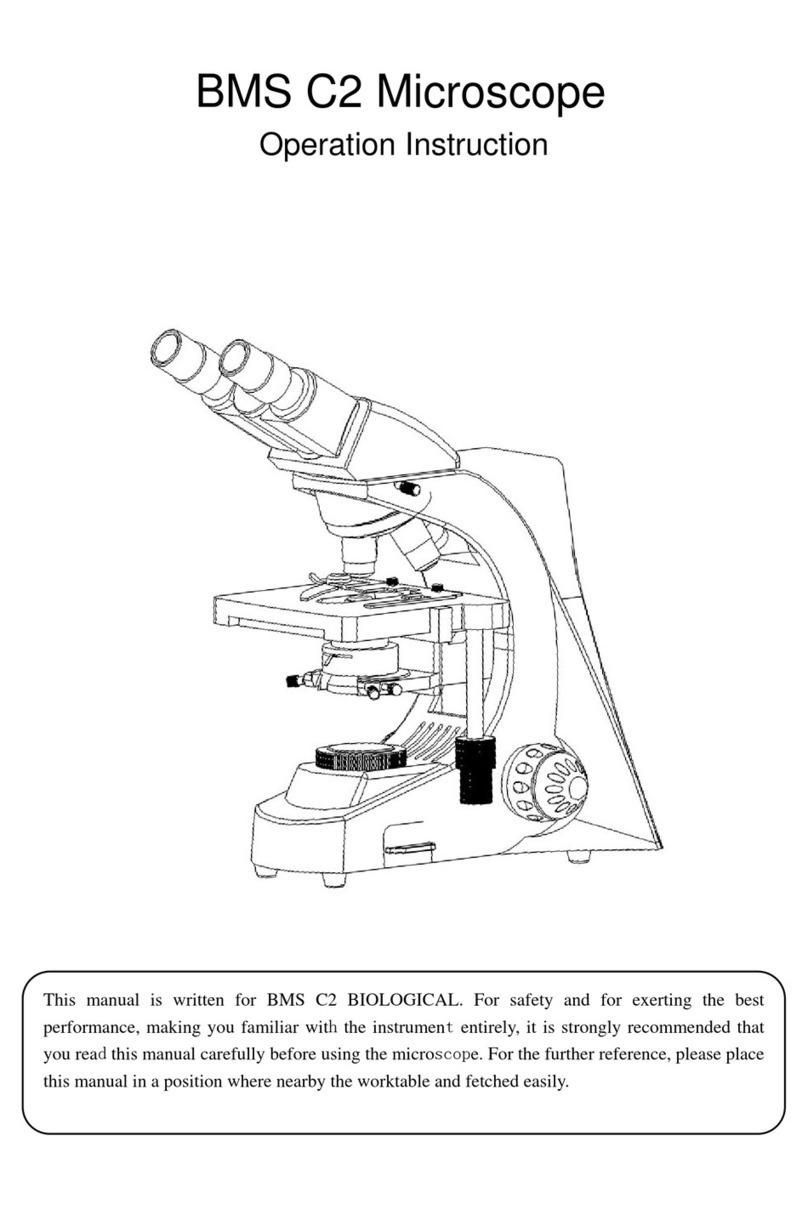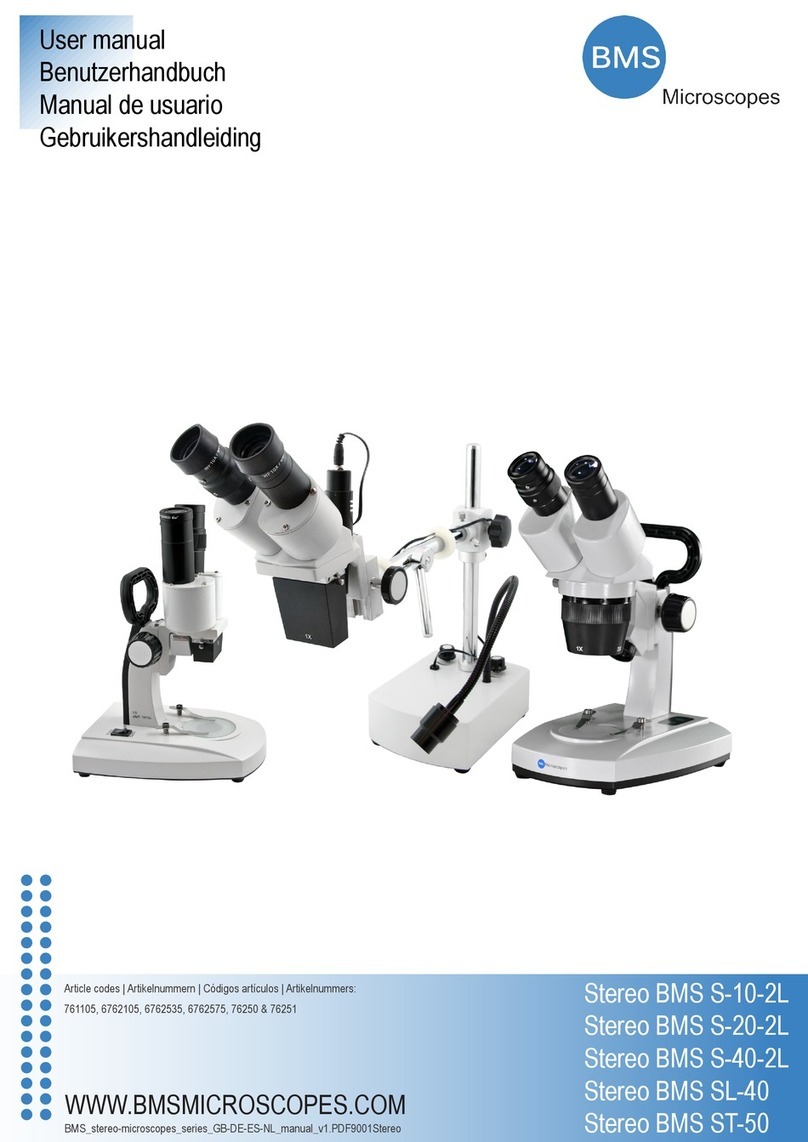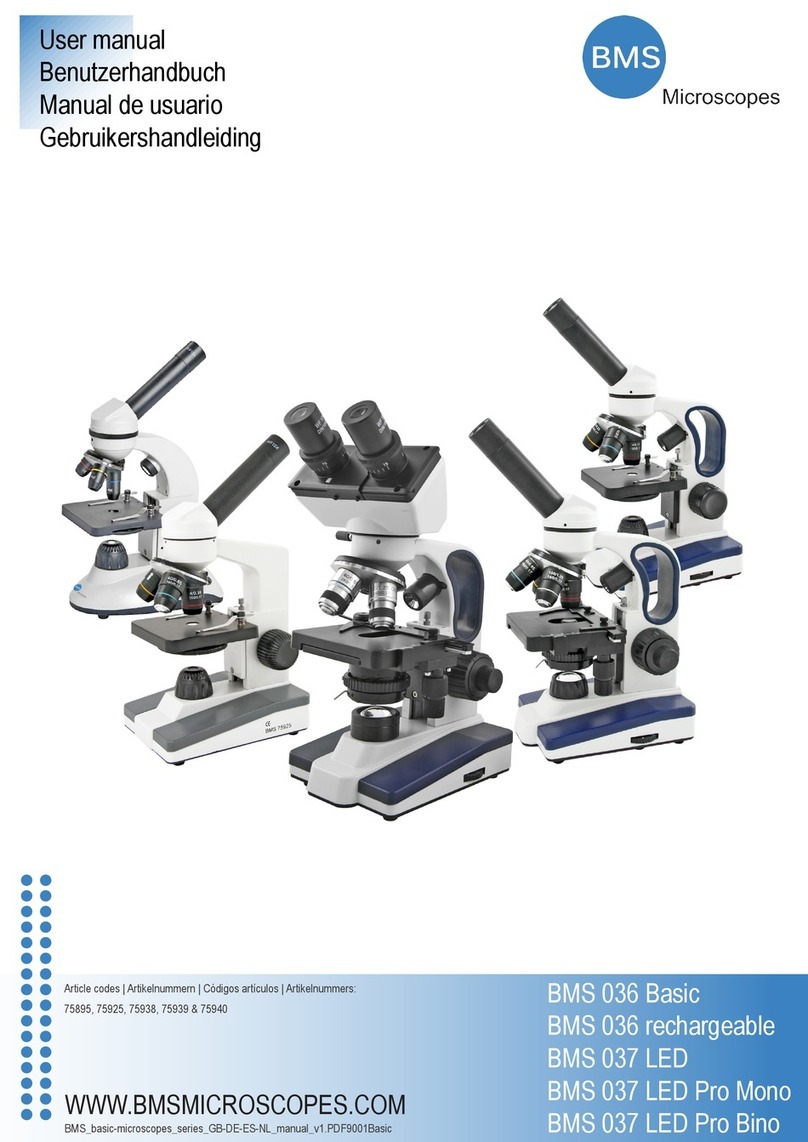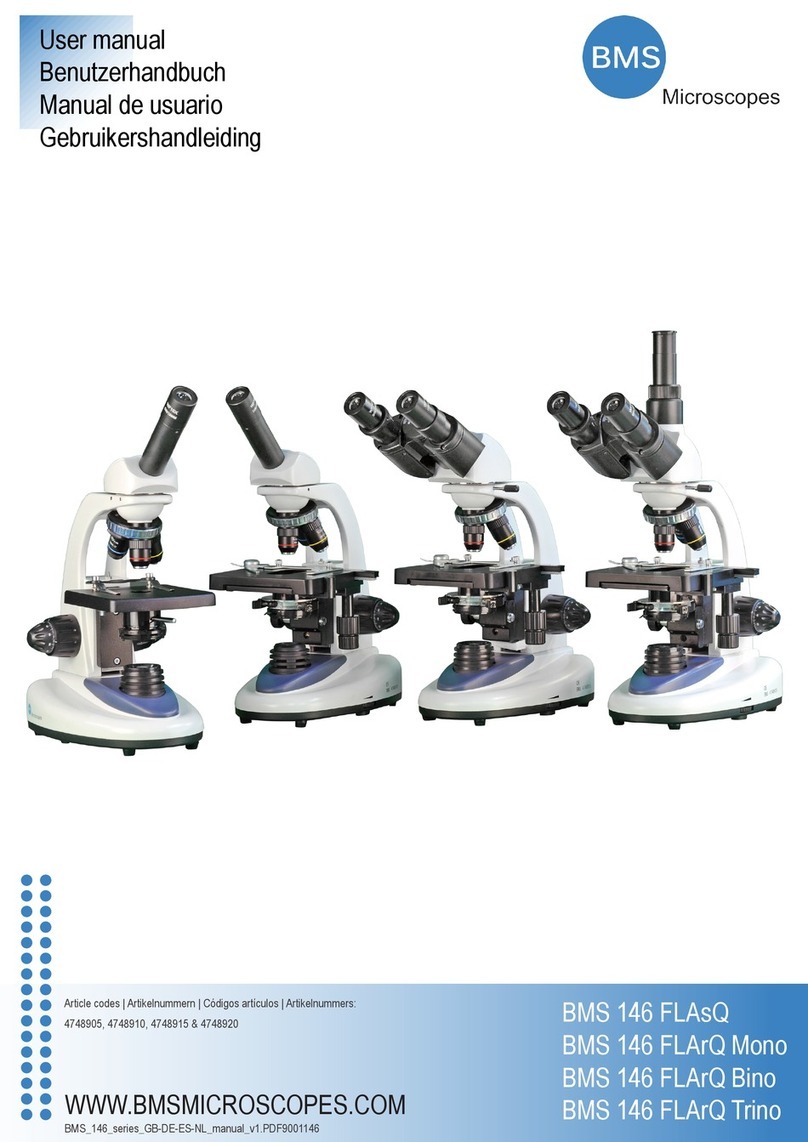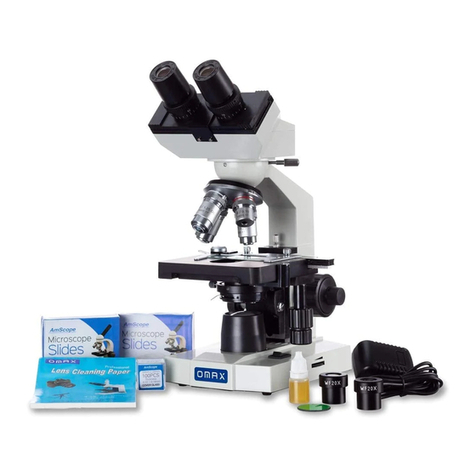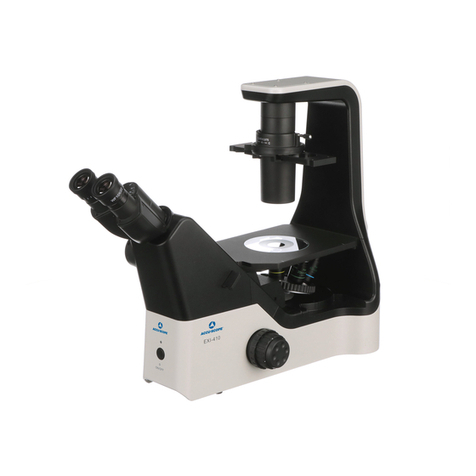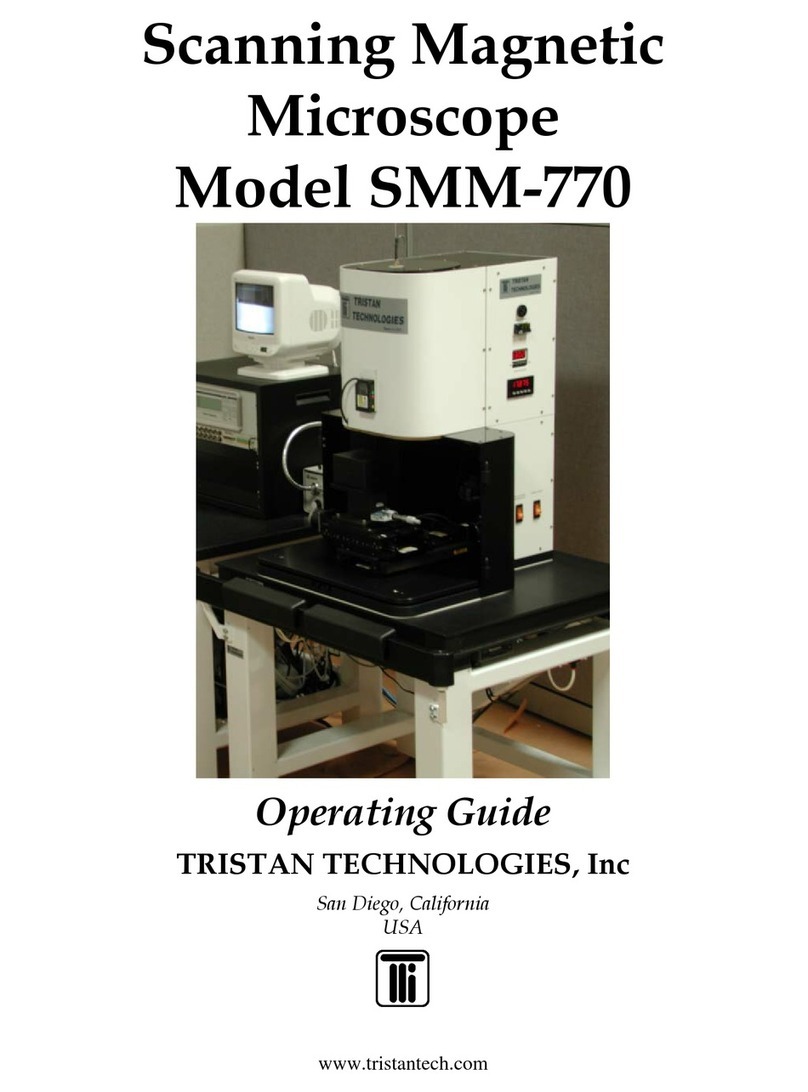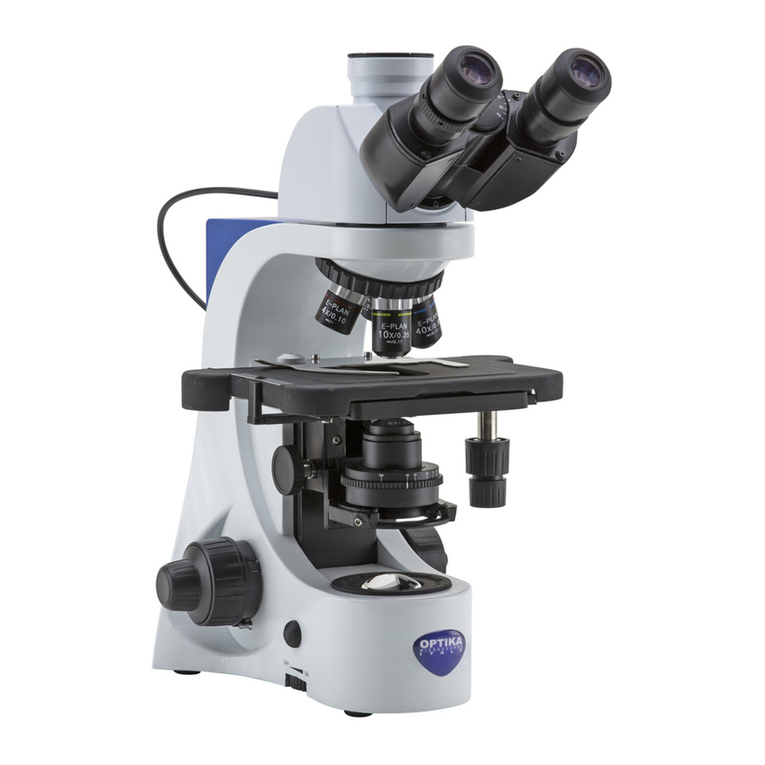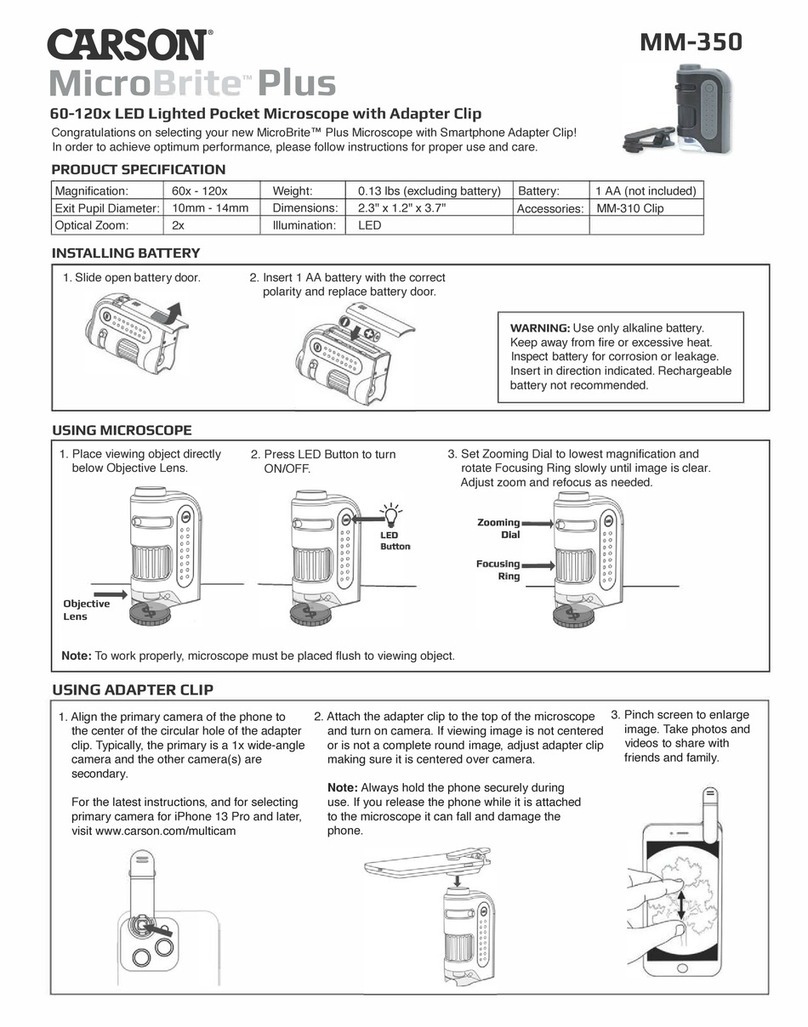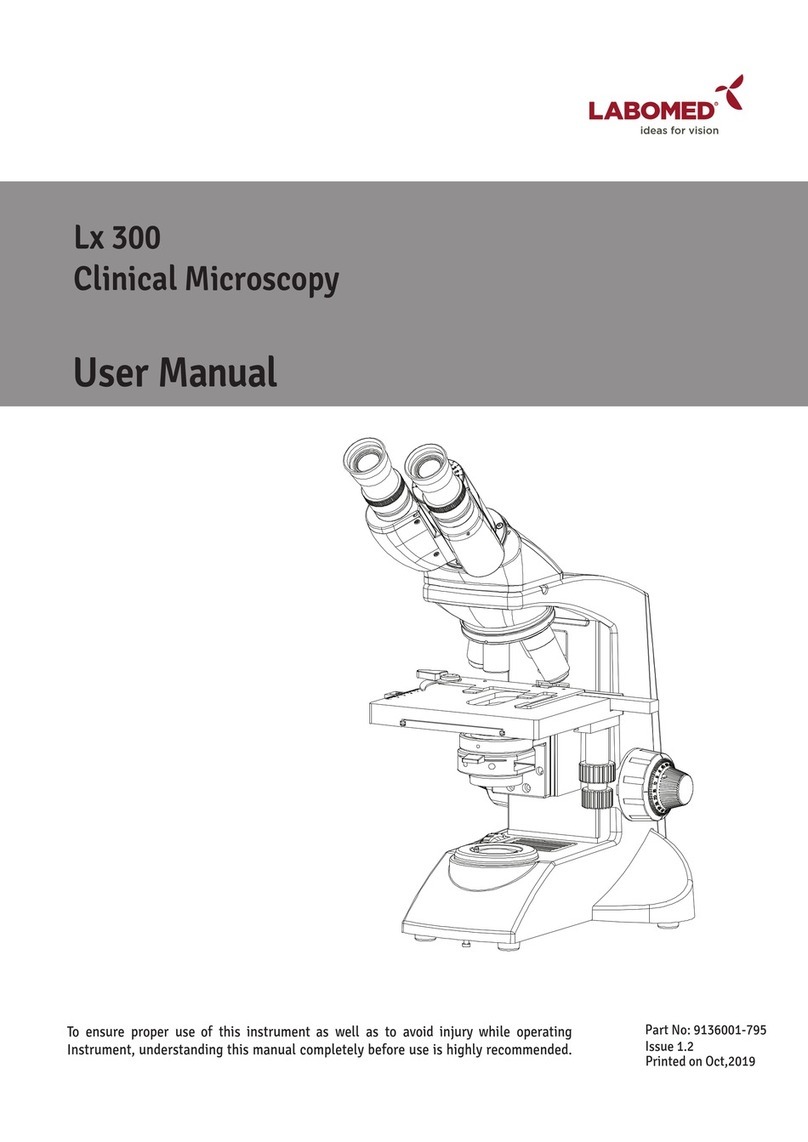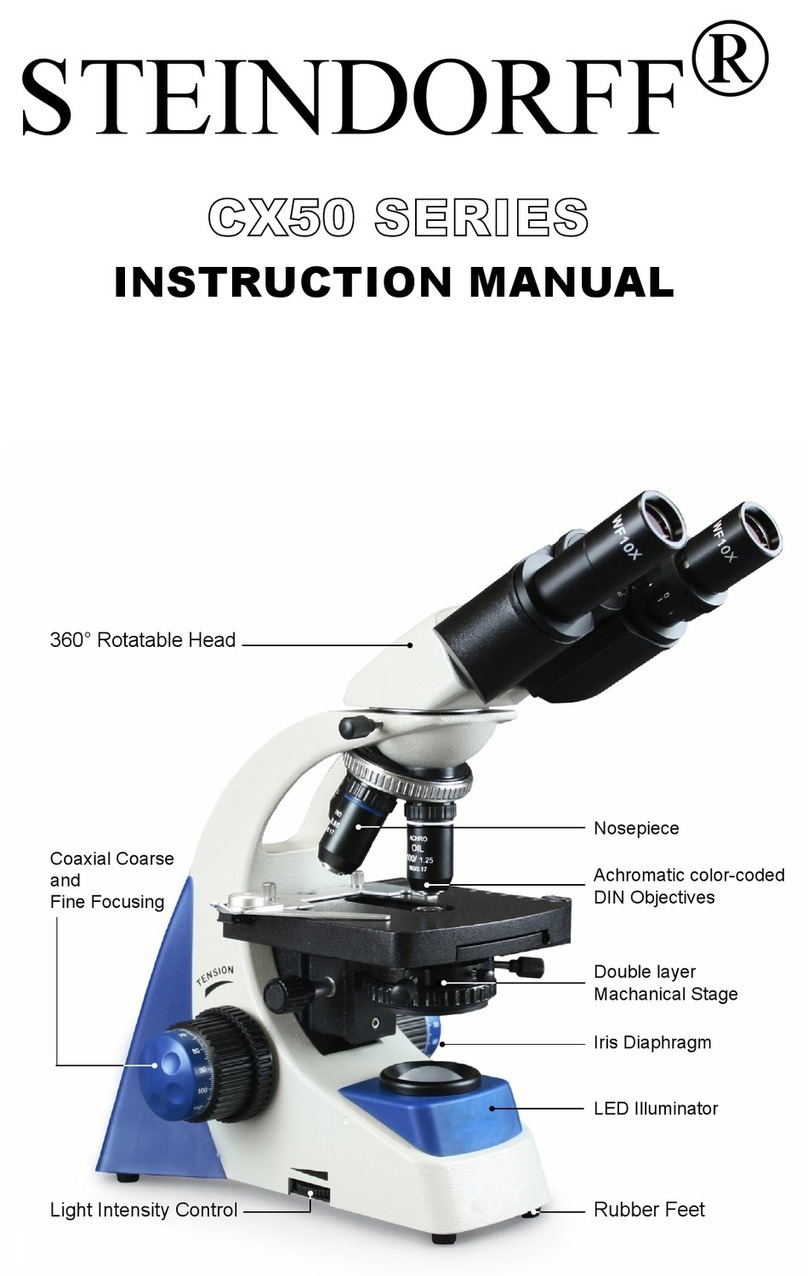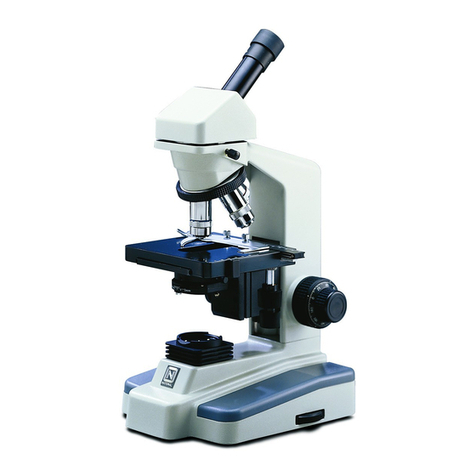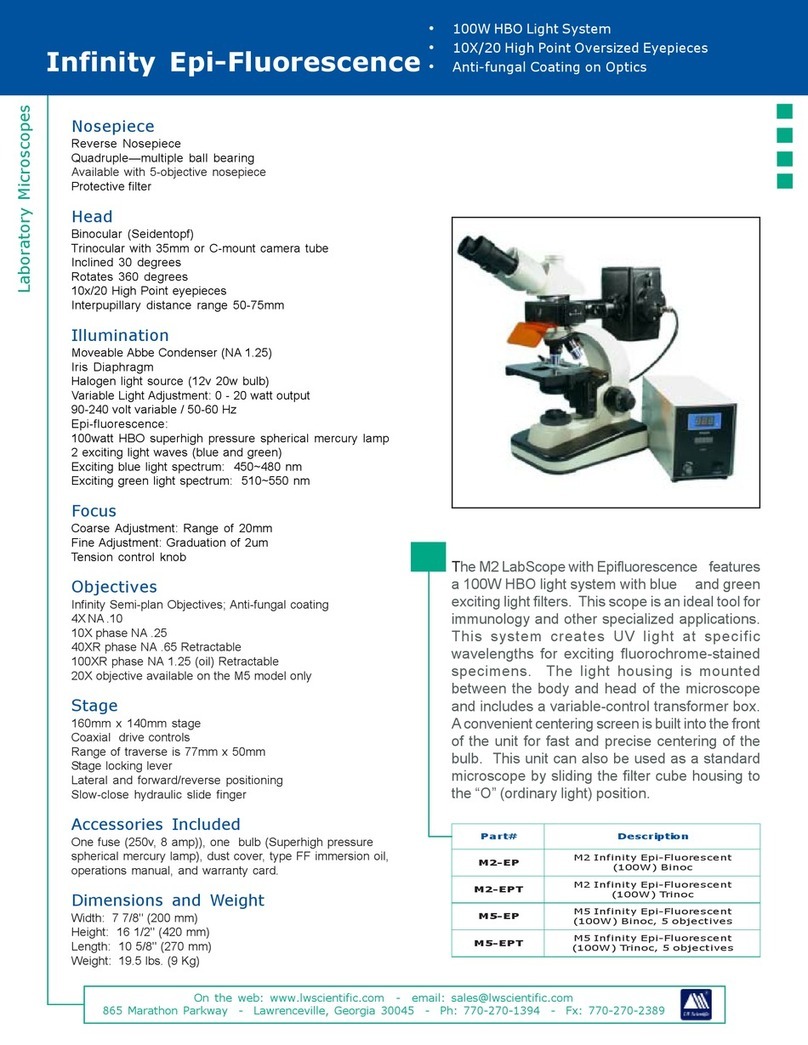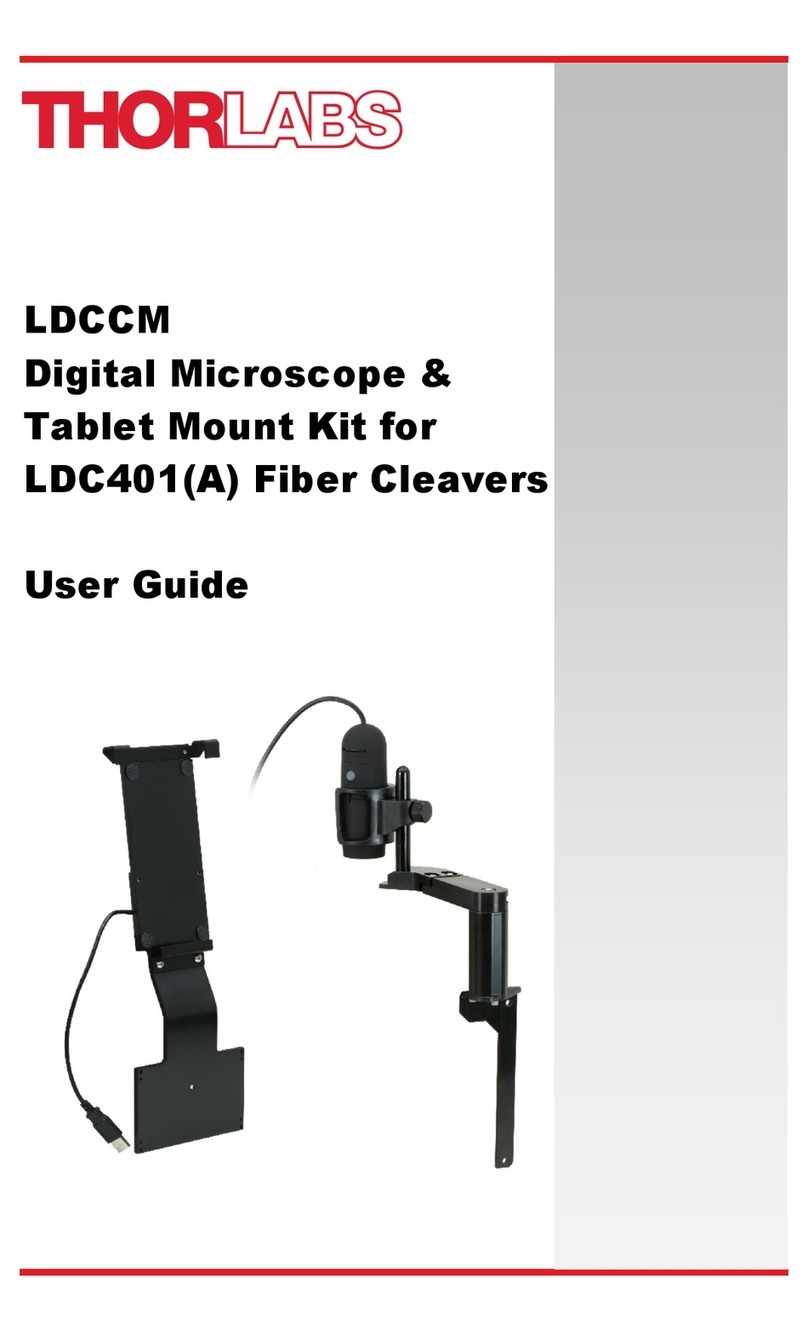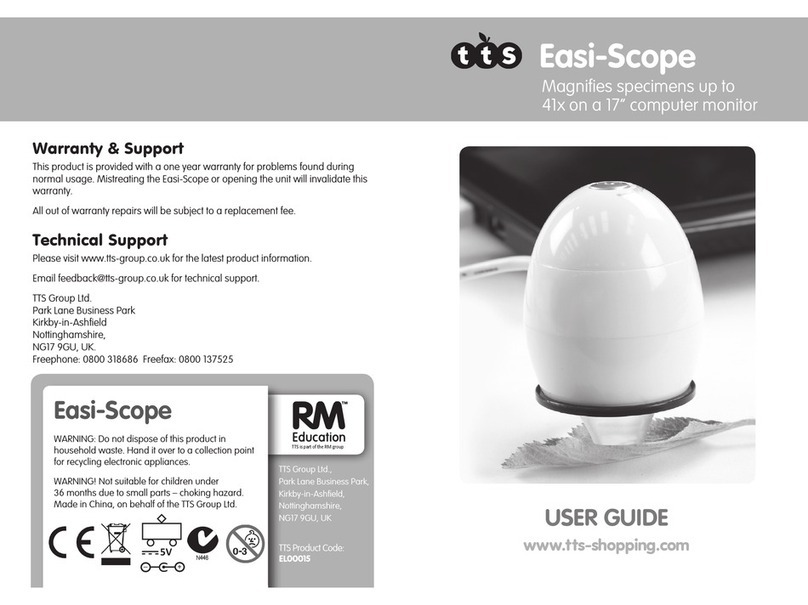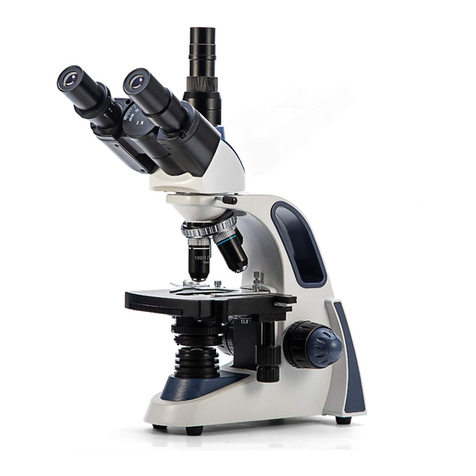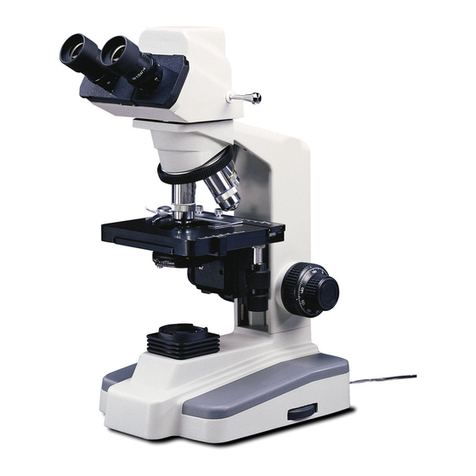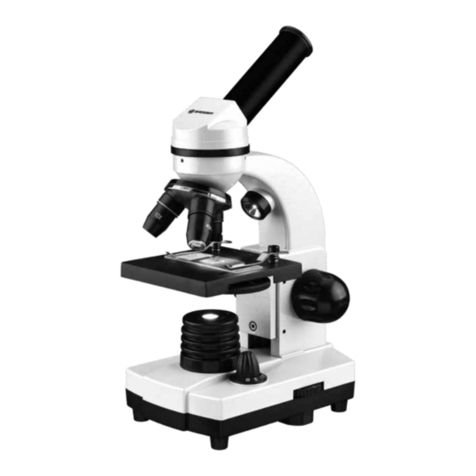BMS D1 Series User manual

BMS D1 series Biological
Microscope
INSRUCTIONS
This manual expatiates the using method, troubleshooting, and maintenance about
the microscope particularly. Please read it before using carefully. The manufacturer
is entitled to amend or improve the instrument.
The quality for this microscope is according to GB/T2985-1999 biological
microscope standard.

Contents D1 series
Before use
1. Nomenclature ……………………………………………………………………..……….1
2. Assemblage ……………………………………………………………………………….3
2-1. Assemble scheme …………………………………………………………………….....3
2-2. Assemble steps ……………………………………………………………………….....4
3. Operation………………………………………………………………………… ….……..6
3-1. Illumination …………………………………………………………………………..6
3-2. Set slides ………………………………………………………………………………..6
3-3. Focusing ………………………………………………………………………………..6
3-4. Adjust tightness of focusing………………………………………………………….....7
3-5. Adjust diopter …………………………………………………………………………..7
3-6. Adjust interpupillary distance ………… …………………………… …………………8
3-7. Adjust center of condenser ………………… ……………………………………….…8
3-8. View field diaphragm … ………………………………………………… ……………9
3-9. Aperture diaphragm………… ………………………………… ………………………9
3-10. Use objective with Oil …………………… ……………………… …………………10
3-11. Use filter ………………… ……………………………………………… ………….10
3-12. Replace fuse………………………………… ……………… ………………………10
3-13. Select light path ……………………………………………………………..……......11
3-14. Set video device ………… …………………………………………………..…….…11
3-15. Set photo adapter ………… …… …… ………………………………………..….…11
4. General specification …………………………………………………………….….… ..12
4-1. D1 series biological microscope specification …………………………………….….12
4-2. Objective parameters ……………………………………………………………….…12
5. Troubleshooting ………………………………………………………………….….… ..13

Figure 1
Before Use D1 series
1. Notice
⑴As the microscope is a precision instrument, a always
operate it with care, avoiding physical shake during the
operation.
⑵Do not let the microscope emerge in the sun directly, either
not in the high temperature, damp, dusty or acute shake
place. Make sure the worktable is horizontal.
⑶When moving the microscope, you should use both hands to
hold ①and ②as shown on figure, and lay it down
carefully. (Figure 1)
★If hold the focusing knob, eyepiece tube or stage
during moving, you will damage it.
⑷During working, the light condenser will become hot.
Please make sure enough space around ③for
cooling.(Figure 2)
⑸Connect the microscope to earth avoid lightning
strike.
⑹Make sure the power switch ④is on “0” (off) before
replacing the bulb or fuse and wait until the lamp
cools down. (Figure 3
★Bulb: 6V/20W halogen bulb(Philips 7388)
⑺It can adapt wide voltage 90~240V. There is no need
for transformer. Make sure the voltage is in this
range.
⑻Use the special plug supplied by our company.
Figure 2
Figure 3

D1 series
2.Maintenance
⑴Wipe the lens gently with a soft lens tissue. Carefully wipe off oil or fingerprints on the lens surfaces with
tissue moistened with a little of 3:7 mixture of alcohol and ether or dimethy lbenzene.
★Alcohol and ether is flammable. Don’t place these chemical near to fire or fire source. For example,
when turning on or turning off the electric device, you should use these chemical in a ventilated place.
⑵Don’t use organic solution to wipe the surfaces of the other components. Please use the neutral detergent.
⑶If the microscope damped by the liquid, you should cut off the power immediately and wipe it dry.
⑷Never disassemble or service the microscope yourself. It will influence its function or damage it.
⑸After using, cover the microscope with a dust cover.
3. Safety Sign
Sign Signification
Read manual before using. Faulty operation would lead to person hurt or
instrument trouble.
| Power swatch ON
O Power swatch OFF

1.Nomenclature D1 series
BMS D1 binocular
1
Eyepiece
Nosepiece
Objective
Stage
Condenser for Normal
illumination
Light condenser for
Normal illumination
Focusing arm
Fine adjusting
knob
Coarse
adjusting knob
Arm
Sliding binocular head

D1 series
BMS D1 trinocular
2
Tightness
adjusting knob
Gemel trinocular head
Light condenser for
Kohler illumination
Condenser for Kohler
illumination
Power switch
Lock-screw
Light adjusting
knob

2. Assemblage D1 series
2-1 Assemble scheme:
The below numbers denote the assembling older.
★Before assembling, make sure there is no dust or dirt. Assemble carefully and do not scrap any part or
touch the glass face.
3
Eyepiece
Objective
Condense
r
Plug
halogen bulb

D1 series
2-2 Assemble Steps 2-2-1 Set Condenser (Figure 4/5)
Set condenser for normal illumination
1.Turn the coarse knob with the direction showed to
make the stage to highest position. (Figure 4)
2. Turn the condenser knob with the direction showed
to make the condenser holder down to suitable
position.
3. Loose the lock screw for condenser thoroughly.
4. Slide the condenser into holder with the direction
showed till it is tied with the holder. And turn the
condenser to make the knob direct to front.
5. Tight the lock screw and use knob moving the
condenser up to highest position.
Set condenser for Kohler illumination
1.Turn the coarse knob with the direction showed to
make the stage to highest position. (Figure 5)
2. Turn the condenser knob with the direction showed
to make the condenser holder down to suitable
position.
3. Loose the lock screw for condenser thoroughly.
4. Put the screw behind condenser matching with the
slot on condenser holder and slide it into
thoroughly.
5. Tight the lock screw and use knob moving the
condenser up to highest position.
2-2-2 Assemble objectives (Figure 6)
1. Turn the coarse knob ①with the direction showed
to make the stage to suitable position. (Figure 6)
2. Assemble the objectives from low to high
magnification clockwise.
Please use objective with low magnification
(such as 4X or 10X) to find the image.
Please make sure correct position with a sound
during turning the nosepiece.
4
图3
图
14
13
5
图
4
图
4
图
4
Figure 5
Figure 4
Figure 6

D1 series
2-2-3 Set or replace bulb (Halogen 7)
◎Please use assigned Philips 7388 halogen bulb 6V20W.
In order to use the bulb longer or prevent blowout,
please do not touch it barehanded. Please swap it
with soft cloth if you leave fingerprint on the bulb.
1. Loose the lock screw ①and turn the bulb holder ②
clockwise.
2. Use gauze or others to take the bulb and set it into bulb
holder ④.
Please set the bulb softly, over press will damage it.
Use or replace bulb
During operation or just after using, the bulb and bulb
holder will be very hot. Please turn the switch to “0”
and take off the plug. After the bulb and bulb holder
cool-down, you can replace the bulb.
This microscope is also suitable for LED
illumination, the operation for LED is similar to
halogen bulb.
2-2-4 Set eyepiece (Figure 8)
1. Take off the cap on eyepiece cap ①.
2. Slide the eyepiece ②into eyepiece tube throughly.
2-2-5 Connect plug (Figure 9)
Do not press the plug too much. Be aware that
bend or enlacement will damage it.
1. Before connect the plug, please turn the switch to
“OFF”.
2. Slide the plug ①into the socket ②on microscope
and make sure good contact. (Figure 9)
3. Connect the other side of the plug to power supply
and make sure good contact.
Please always use the plug supplied by manufacturer. If
damage or lost, please use same specification one.
★It adopt wildly power supply 90-240V.
★Please connect the power supply correctly, be sure the
instruments to be connected with earth.
Figure 8
Figure 9
Figure 7

5
3. Operation D1 series
3-1 illumination (Figure 10)
1. Set the power switch ①at “ON” after connect power
suppler.
2. Use knob ②to adjust the brightness more comfortable.
Clockwise for brightness and counter-clockwise for darkness.
(Figure 10)
Under low power, the bulb will have long life.
3-2 Set slides (Figure 11)
1. Push the clamp ①.
2. Put the slides ②on specimen holder and make sure the
frontispiece up towards. Then loose clamp ①to tight the
slides. (Figure 11)
3. Adjust the knob to move the slides to center (according
to center of objective).
3-3 Focusing (Figure 12、14、15)
1. Let objective 4X move into light path.
2. Turn one dioptor ring to make it in line with
reticle on eyepiece tube. At this time, the
position is “0”. (Figure 14)
3. Turn coarse knob to find the image. (Figure 12)
4. Adjust anther dioptor to make the image clear.
(Figure 14)
5. Turn fine knob to make the image clear. (Figure
12) (Suitable for sliding head)
Or
1. Let objective 4X move into light path.
2. Turn one dioptor ring to make “0” position in
line with reticle on eyepiece tube. (Figure 15)
3. Turn coarse knob to find the image. (Figure 12)
4. Adjust anther eyepiece to make the image clear. If
not, please adjust dioptor. (Figure 15)
5. Turn fine knob to make the image clear. (Figure
12) (Suitable for gemel head)
Figure 11
Figure 12
Figure 10

6
D1 series
3-4 Adjust tightness of focusing
If the coarse adjustment is too tight or uncomfortable
or image swiftly out of focal plane after focusing or
the stage sleeks down, please use knob to adjust.
(Figure 13)
Turn the knob with the direction showed to tight
the knob. And opposite direction for loosement.
3-5 Adjust diopter (Figure 14&15)
1. Turn one dioptor ring to make it in line with
reticle on eyepiece tube. At this time, the
position is “0”. Use objective 10X and adjust
another diopter ring to make image clear. (Figure
14)
(Suitable for sliding head)
Or
Turn one dioptor ring to make “0”position in line
with reticle and make the image clear. Then
observe through another eyepiece. If the image is
blur, please adjust another diopter till the image
clear. (Figure 15)
Diopter is ±5 and when it is in line with reticle
, the number is the eye’s diopter.
Please remember own diopter for future using.
(Suitable for gemel head)
7
Figure 14
Figure 15
Figure 13

D1 series
3-6 Adjust interpupillary distance
Slide the board with direction showed to make
image through both eyepieces syncretic. (Figure
16)
The interpupillary distance: 52-75mm
Please remember own interpupillary distance
for future using.
(Suitable for sliding head)
Turn both prism houses to adjust interpupillary
distance till the image through both eyepiece
syncretic.
The “。” on eyepiece tube point to reticle ,
then the number is interpupillary distance. (Figure
17)
Interpupillary distance: 50-76mm
Please remember own interpupillary distance
for future using.
(Suitable for sliding head)
3-7 Adjust center of condenser
1. Turn the condenser up-down knob with the
direction showed to make the condenser to top
position. (Figure 18)
2.Slide10Xobjectiveintolightpathtofindimage.
3.TurntheringonviewfielddiaphragmtoMin..
At this time, you may find image for the
diaphragm.
4. Adjust the condenser holder knob to make the
diaphragm image clear.
5. Adjust the adjusting-screw on condenser to
make the diaphragm image center. (Figure 19)
6. Open the view field diaphragm slowly. If the
diaphragm image is always at center and inscribed
with view field, then the condenser has been
centered.
7. During operation, please open view field
diaphragm a little to make the its image exscribed.
8
Figure 18
Figure 17
Figure 16

D1 series
3-8 View field diaphragm(Figure 19)
The view field diaphragm can prevent the light
diameter into condenser in order to remove
varied-light and strength the image. When the image
of view field diaphragm is just outside of view field,
the objectives can provide optimal performance to
get the clearest image.
3-9 Aperture diaphragm (Figure 20&21)
1. Aperture diaphragm determines aperture number
of illumination. Only when the aperture number
for illumination and objective is matching, you
can get the better resolution and contrast of image
and to increase depth of field.
2.Asthecontrastofsampleformicroscopeisvery
low, please turn the knob during operation to let
the arrowhead point to number chip which shows
same magnification as objectives. That means
adjust the aperture diaphragm of condenser to
70-80% of objective aperture. If necessary, take
off the eyepiece and observe through eyepiece
tube and adjust knob till finding the image
Figure 18. (Figure 20&21) ( shows aperture
diaphragm and shows objective edge in Figure
20 )
9
Figure 20
Figure 21
Figure 19

D1 series
3-10 Use objective (100X) with oil
1. Use objective 4X to find image.
2. Drop oil on sample. (Figure 22)
3. Turn the nosepiece counter-clockwise and slide
the objective 100X into light path. Then turn fine
adjusting knob to make image clear.
Make sure no bubble inside oil because any
bubble will affect image quality.
A. Please take off eyepiece and open view field
diaphragm and aperture diaphragm thoroughly,
then observe through eyepiece tube to check
bubble. (If the edge of the objective is round and
bright, there is without bubble.)
B. Please turn nosepiece softly and let the 100X
objective swing the oil to wipe off the bubble.
4. After use oil, please clean the objective with 3:7
mixed alcohol and ether or dimethylbenzene on
cloth. Also please wipe off the oil on sample.
Do not turn other objective into light path
before wipe off oil on sample to avoid oil
moisten objectives.
It will dissolve glue on prism if use
more dimethylbenzene.
3-11 Use filter (Figure 23)
Filter can make the background of image more
suitable. No filter for the LED version.
There are blue, green, yellow and neutral for
selection.
3-12 Replace fuse (Figure 24)
Put the power switch on “OFF” before replacing the
fuse. Cut the power supply first, then screw off the
fuse group from the fuse base with “-”
screwdriver. And put a new fuse and screw on the
fuse base. (Fig.24)
Specification: 250V,3.15A.
10
Figure 23
Figure 24
Figure 22

Figure 25
D1 series
3-13 Select light path (Figure 25)
The light path selecting levercontrols the prismatic
between binocular and trinocular. When the lever
is in the most inside, light enters the binocular fully;
when the lever is in the most outside, the
prismatic is 8:2 for binocular and trinocular. Usually,
push the lever to the most inside when using the
binocular and push it to most outside when using the
trinocular (TV or Photo). (Fig.25)
3-14 Set Video device (Figure 26)
1. Loose the lock-screw on trinocular head and
take off the cap on third tube. (Fig. 26)
2. Take off the cap on TV adapter and screw the
adapter into third tube with the direction showed
and lock it.
3. Loose the lock screw on TV adapter and take
off C-mount , and screw in CCD or vidicon.
Then screw the whole adapter into TV adapter and
lock the screw .
4. Pull the light path selecting lever to the most
outside for observation for binocular. Adjust the
tube till image clear
3-15 Set photo adapter (Figure 27/28)
1. Loose the lock-screw on trinocular head and
take off the cap on third tube.
2. Set the photo adapter into third tube with the
direction showed and lock the screw . (Fig. 27)
3. Loose the lock-screw and take off photo tube.
4. Set 3.2X photo eyepiece into the eyepiece hole
and put on photo tube , then lock on screw .
5. Observe through binocular till image clear, then
pull the light path selecting lever to the most
outside. And operate under the manual of camera.
11
Figure 26
Figure 27
Figure 28

4. General Specification D1 series
4-1 D1 series biological microscope specification
4-2 Performance for objectives
12
Optical system Color corrected optical system
Head
Sliding binocular head, 45°inclined, 360°rotatable
Gemel binocular head, 30°inclined, 360°rotatable
Gemel trinocular head, 30°inclined, 360°rotatable with prismatic: binocular100%,
binocular/trinocular 80%/20%
Eyepiece PL10X high point plan eyepiece, 18mm
Nosepiece Build-in quadruple nosepiece
Objective High contrast achromatic objective (4X, 10X, 40X, 100X)
Plan achromatic objective (4X, 10X, 40X, 100X)
Focusing
Fine and coarse coaxial focusing with top limited for coarse and tightness adjustment.
Moving range 28mm.
Precision: 0.002mm
Stage Dual mechanical stage 140*132mm with moving range 76*50mm, low adjustment
Illumination 85~265V wildly power supply, transmitted normal illumination, 6V20W halogen bulb,
adjustment of brightness
Operation
environment
●Indoor using
●Altitude: below 2000m
●Surrounding temperature: 5-40 (41-109)
●Max. humidity: 80% humidity for 31(88), 70% humidity for 34(93),60% humidity
for 37(99),50% humidity for 40(104)
●Contamination: 2 (refer to IEC664)
Item Magnification
Numerical
aperture
(N.A)
Conjugate
distance (mm)
Parfocus
distance (mm)
Cover glass
(mm)
Mag.
Remark
(ring color)
4X 0.10 195 45 0.17 Red
10X 0.25 195 45 0.17 Yellow
40X(S) 0.65 195 45 0.17 Blue
High
contrast
achromatic
objective 100X(S)(OIL) 1.25 195 45 0.17 White
4X 0.10 195 45 0.17 Red
10X 0.25 195 45 0.17 Yellow
40X(S) 0.65 195 45 0.17 Blue
Plan
achromatic
objective
100X(S)(OIL) 1.25 195 45 0.17 White

5. Troubleshooting D1 series
Symptom Cause Remedy
1. Opticis
View field diaphragm is not large enough Open the diaphragm more
Condenser is too low Adjust condenser position
Condenser is not center Center condenser
The lamp is not
bright enough
Light path selecting lever is not at position for
binocular Pull it to position for binocular
Nosepiece is not on the right position Turn it to right position
the edge of view
field is dark or even Dust on lens(condenser, objective or eyepiece) Clean them
Stain on sample Clean sample
stain inside of view
field Stain on lens(condenser, objective or eyepiece) Clean them
No cover glass on sample Add cover glass
The cover glass is not the standard Please use standardδ0.17mm
Sample is faced down Put it again
Oil on (dry) objective Clean the objective
No oil on objective (oil) Use oil
Bubble inside oil Wipe off bubble
Wrong immersion oil Use right one
Aperture diaphragm is not opened correctly Adjust it
Stain or dust on prism of eyepiece Clean it
image blur
Condenser is too low Adjust it
The sample is not fixed Fix it
Nosepiece is not at right position Turn it to right position
one side of image is
dark or image swing
while focusing
Condenser is not center Center condenser
13

D1 series
Symptom Cause Remedy
interpupillary is not correct Adjust it
Diopter is not correct Adjust it
The eyes tired easily.
The both view field are
not superposition The both eyepieces are different Please use same one
2. Mechanics
Cover glass faced down Put it again
image is not focused
while using high Mag.
Objective- The cover glass is not the standard Please use standardδ0.17mm
Cover glass faced down Put it again
The objective
touched cover glass
while turning from low
Mag. to high Mag.
The cover glass is not the standard Please use standardδ0.17mm
Coarse knob is too
tight Tightness adjusting ring is too tight Adjust it to suitable
The stage skipped
down slowly while
observation
Tightness adjusting ring is too loose Adjust it to suitable
The coarse knob can
not be adjusted up The top limited screw locked Loose the screw a bit
The coarse knob can
not be adjusted down The condenser holder is too low Rise it
The sample is not set correctly Re-set it
The specimen can not
be moved smoothly Specimen holder is not fixed Fix it
3. Electrics
No power supply Connect it
The bulb is not fixed correctly Set it correctly
The bulb is not light
The bulb burnt out Replace bulb
The bulb burnt out
usually The bulb is not standard Please use standard bulb
The bulb is not standard Please use standard bulb
brightness is not
enough Brightness adjusting knob is not used right Use it right
The bulb will be burnt out soon Replace bulb
light flashes
The wires are not connected all right. Connect them correctly
14
Table of contents
Other BMS Microscope manuals
